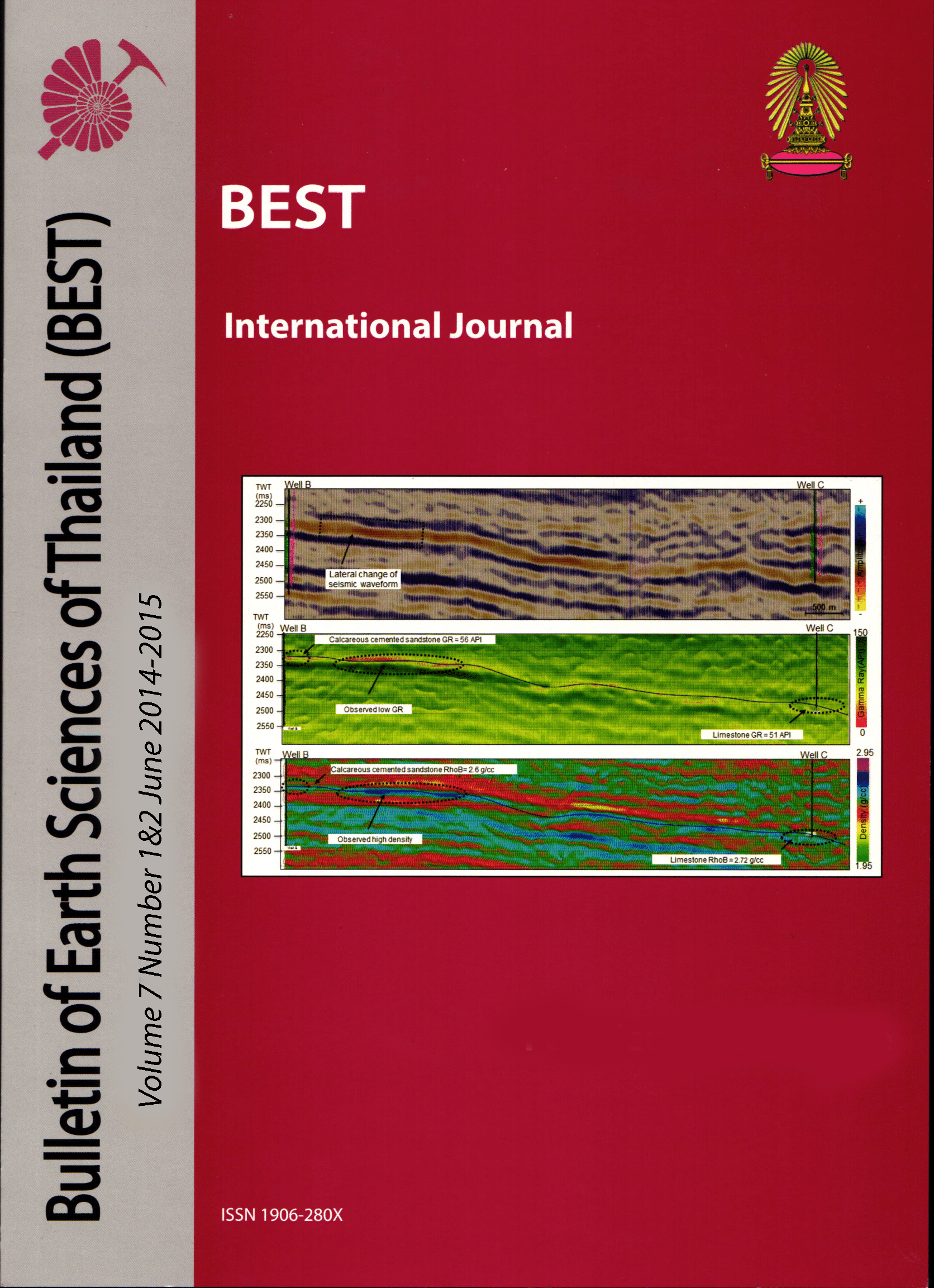Evaluation of Post-stack Seismic Inversion Techniques for Detection of Sands in Gulf of Thailand
Main Article Content
Abstract
The majority of petroleum production in Thailand comes from the Pattani Basin of the Gulf of Thailand. The fluvial sands are the target reservoirs in this area. To predict these reservoirs is not always easy using conventional seismic amplitudes because of rapid lateral and vertical lithological variations due to the fluvial depositional environment. Rock physics analysis and different post-stack seismic inversion techniques were applied to detect sands within the study area. Moreover, the study also evaluates different post-stack seismic inversion techniques for accurate prediction of the sand reservoirs. According to rock physics analysis, P-impedance can differentiate sands from shales in the shallow (from Middle Miocene Unconformity to Lower Middle Miocene) and deeper (below the Upper Lower Miocene) stratigraphic intervals, but not for the middle section in between that. Therefore, post-stack inversion solving for P-impedance is only suitable for shallow and deeper sections not for middle section. Model Based, Band limited and Sparesspike (Linear programming and Maximum likelihood) inversions show reasonable correlation at well locations whereas Colored inversion shows lowest correlation coefficient. Blind test results shows that Model Based inversion is more effective in area
close to used wells for initial guess model, but Colored inversion performed better in the area away from the used wells for initial model. Model Based inversion scales P-impedance by using well data, whereas, Colored inversion is mostly seismic data driven. Therefore, in the case of good well control Model Based inversion works better, but in the case of poor well constraint, Colored inversion can provide reasonable prediction for P-impedance. The predicted P-impedances are low for sands in shallower and deeper sections. In the middle section, it is not easy to isolate sands from shales. In deeper section, sands with thickness less than 30 m cannot be detected on inverted volumes. This may be due to tuning phenomena. Sand bodies can be extracted along horizon slice by applying cutoff for Pimpedance. Cutoff values for sand can be computed from cross-plots. The extracted sand bodies along horizon slices are promising targets for future exploration and development programs.
Article Details

This work is licensed under a Creative Commons Attribution-NonCommercial-NoDerivatives 4.0 International License.
Copyright © 2008 Department of Geology, Faculty of Science, Chulalongkorn University. Parts of an article can be photocopied or reproduced without prior written permission from the author(s), but due acknowledgments should be stated or cited accordingly.
References
Ahmad, M. N. and Rowell, P., 2013, Mapping of fluvial sand systems using rock physics analysis and simultaneous inversion for density: case study from Gulf of Thailand: First break, v. 31, May 2013, p. 49-54.
Pendrel, J.V., and P. van Riel, 1997, Methodology for seismic inversion and modeling-a western Canadian reef example: Canadian Society of Exploration Geophysicists Recorder, v. 22, no. 5.
Pendrel, J.V., 2006, Seismic inversion-the best tool for reservoir characterization, CSEG Recorder, p. 5-12.
Priyanto, B., 2012, Lithology prediction using rock physics analysis and seismic inversion within Miocene fluvial reservoir interval in the Songkhla Basin, Gulf of Thailand: M.Sc. thesis, Chulalongkorn University, 86 p.
Russell, B. and Hampson, D., 1991, Comparison of Post-stack Seismic Inversion Methods, SEG Expanded Abstracts, 10, 876-878.
Russell, B., 1988, Introduction to seismic inversion methods: The SEG course notes Series, 2.
Swisi, A., 2009, Post- and Pre-stack attribute analysis and inversion of Blackfoot 3D seismic dataset: M.Sc. thesis, University of Saskatchewan, 145 p.
Visadsri, P., 2013, Prediction of reservoir sands by using rock physics and simultaneous inversion: Case study from the Pattani Basin, Gulf of Thailand: M.Sc. thesis, Chulalongkorn University, 141 p.


